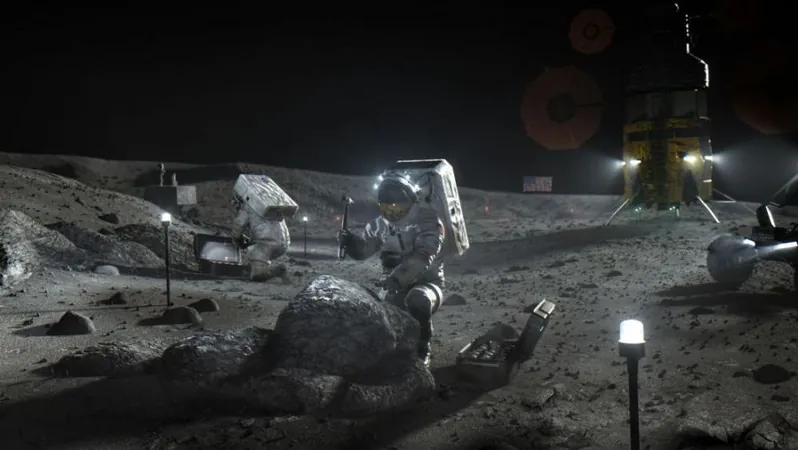
The Countdown to the Stars: Why New Timekeeping Is Crucial for Human Exploration Beyond Earth
2025-01-06
Author: Emma
Introduction
As humanity sets its sights on exploring and potentially inhabiting other celestial bodies, ambitious plans are underway spearheaded by NASA, various space agencies, and private enterprises. These initiatives aim to establish lasting infrastructures on the Moon and beyond, allowing for sustained human presence and operations that encompass scientific research, commercial endeavors, and exploration.
The Need for Standardized Timekeeping
Among the many challenges posed by these frontier-pushing missions, a critical yet often overlooked aspect is the need for a standardized timekeeping system. As we strive to coordinate lunar activities, operations in orbit, and communications back to Earth, developing a robust lunar time system becomes essential. A recent study by a team of scientists from NASA's Jet Propulsion Laboratory has proposed a new methodology for lunar timekeeping based on the principles of relativistic time transformations—a concept derived from Einstein's theories of relativity.
Relativistic Time Transformations
According to Slava G. Turyshev, one of the research scientists involved, "Relativistic Time Transformations (RTT) factor in how time flows differently based on gravitational potential and motion." Notably, this means that time on the Moon actually ticks faster than on Earth due to its relatively weaker gravitational pull. Although the differences are minuscule—measured in microseconds—they significantly influence the accuracy of space missions where even the slightest timing error can have far-reaching consequences.
Primary Time Scales for Lunar Missions
In their findings, Turyshev and his colleagues outlined three primary time scales critical for lunar missions: 1. **Terrestrial Time (TT)**: The standard time scale used for Earth-based operations, which factors in corrections for Earth's gravitational potential. 2. **Barycentric Coordinate Time (TCB)**: This scale serves as the time standard within the Barycentric Celestial Reference System, accounting for relativistic effects of celestial bodies relative to their barycenter. 3. **Barycentric Dynamical Time (TDB)**: An adjusted version of TCB that maintains alignment with Terrestrial Time over extended durations, crucial for consistency in astronomical observations.
Implications for the Artemis Program and International Missions
The team's research is vital as NASA's Artemis Program and international counterparts—including projects from China and Russia—aim for missions that will eventually station humans on the Moon permanently. The Artemis program will deploy several components that must work in sync, including the Lunar Gateway and the Lunar Base Camp, as well as promote joint initiatives like the planned Moon Village by the European Space Agency.
Commercial Interests and Lunar Timekeeping
The need for standardized lunar time becomes even more pressing as commercial interests begin to stake a claim in lunar resources, from mining operations to potential tourism. Every mission, regardless of its nature—be it scientific, commercial, or exploratory—will require precise timing to avoid errors that could jeopardize mission success.
Creating a Lunar Time Scale (LT)
As lunar exploration efforts ramp up, creating a dedicated Lunar Time (LT) scale and Luni-centric Coordinate Reference System is essential. This new system will help manage the inherent complexities of timekeeping in an environment influenced by varying gravity fields, the Moon’s orbit, and localized gravitational anomalies.
Lunar Time Drift
The researchers have determined that lunar time drifts ahead of Earth time by approximately 56 microseconds per day, affected by regular oscillations caused by its orbit. Utilizing intricate data from NASA’s Gravity Recovery and Interior Laboratory (GRAIL) mission, they achieved remarkable precision in modeling the Moon's gravitational dynamics, facilitating this advanced timekeeping system.
The Importance of Precise Timekeeping
This paradigm of lunar navigation and communication underscores the importance of precise timekeeping across multiple facets of lunar exploration. Synchronized timekeeping can enhance navigation accuracy, enable seamless communication between Earth and lunar bases, and foster collaborative scientific endeavors across international missions.
Looking Ahead: Interplanetary Timekeeping
Looking ahead, as humanity reaches further into our cosmic neighborhood with ambitions toward Mars, similar adaptations in our approach to time will become necessary. Concepts like Mars Coordinated Time (MCT) and the Darian Calendar are already being explored to facilitate interplanetary consistency.
Conclusion
We stand on the brink of a new era, and as we carve out our place in the cosmos, reimagining our concept of time may very well define our success among the stars! Keep your eyes on the sky—human interplanetary travel is not as far off as it may seem!









 Brasil (PT)
Brasil (PT)
 Canada (EN)
Canada (EN)
 Chile (ES)
Chile (ES)
 Česko (CS)
Česko (CS)
 대한민국 (KO)
대한민국 (KO)
 España (ES)
España (ES)
 France (FR)
France (FR)
 Hong Kong (EN)
Hong Kong (EN)
 Italia (IT)
Italia (IT)
 日本 (JA)
日本 (JA)
 Magyarország (HU)
Magyarország (HU)
 Norge (NO)
Norge (NO)
 Polska (PL)
Polska (PL)
 Schweiz (DE)
Schweiz (DE)
 Singapore (EN)
Singapore (EN)
 Sverige (SV)
Sverige (SV)
 Suomi (FI)
Suomi (FI)
 Türkiye (TR)
Türkiye (TR)
 الإمارات العربية المتحدة (AR)
الإمارات العربية المتحدة (AR)